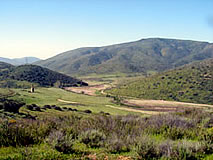The Multiple Species Conservation Program, or MSCP, will benefit from new scientific studies of the golden eagle and quino checkerspot butterfly.
The MSCP, adopted by several jurisdictions in the late 1990’s, is a comprehensive plan to conserve San Diego’s heritage of species and habitats, and to mitigate the impacts of future development. It is designed for “adaptive management” over time that incorporates new information obtained from monitoring studies and responds to events such as wildfires. Such assurances are a complement to assurances for development, which, once built, cannot be removed. It also procedures to “cover” species that may become listed subsequent to plan adoption but were not included on the initial list of conserved species. In these ways, the plan and its permits remains current and “properly functioning.”

The golden eagle is one of the MSCP covered species being followed by the San Diego Association of Governments Mitigation and Monitoring Program. Eagles have been captured and tagged county-wide by the United States Geological Survey. Tracking data will be used to assess if the MSCP is keeping its promise to maintain a minimum number of eagle pairs, and whether new development is compatible with eagle objectives. It is important to remember that the MSCP anticipates and requires exactly this sort of monitoring and science-based adjustment.
In a related action, the County of San Diego is preparing a “Quino Amendment” to add the endangered quino checkerspot butterfly to the MSCP. This amendment will also inform development decisions on projects now being processed. EHL seeks a comprehensive program for quino conservation. Once this strategy is known, priority would be given to better managing already conserved lands and then consideration of preserve design changes. If such modification is needed, the MSCP also addresses how such costs would be allocated.
EHL supports both the adaptive management program and the Quino Amendment.


